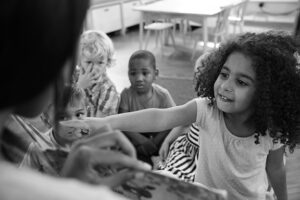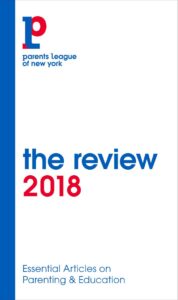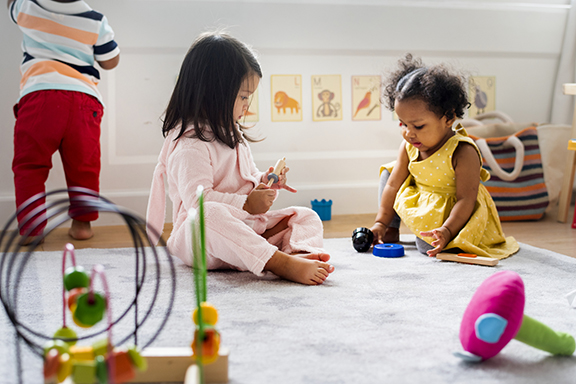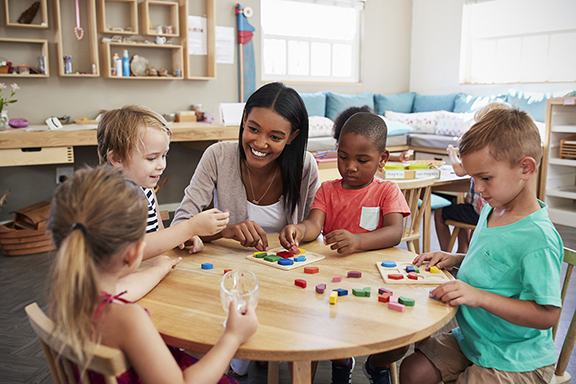The Gift of Bilingualism

Like many Americans, I began to study a foreign language in high school, which was the first time I had the opportunity to do so. I was excited by the idea of learning another language and quickly found that I had a knack for verb conjugation and grammar rules. On paper, it seemed so easy.
Fluency was another matter, however, and my first trip to Spain in college got off to a rough start. Summoning the confidence to chat with native speakers and listening carefully for comprehension was so much more difficult than I had thought it would be. My Spanish host mother even insisted that my roommate, a quadrilingual student from Taiwan, interpret for us, because trying to converse with me was simply too painful for her.
Although I am happy to say that my spoken Spanish greatly improved during the trip and, while my Spanish has continued to improve over the years, it is unlikely to ever be near-native. How much easier it would have been to learn a foreign language when I was young.
While many countries prioritize early acquisition of a second or third language, the United States continues to be slow to recognize the value of early acquired bilingualism. Some families and some schools, however, do understand its value. Realizing the need for a Spanish immersion preschool in Manhattan, La Escuelita opened its doors in 2002 on the Upper West Side, where we have witnessed young children easily and joyfully acquire proficiency in Spanish along with the skills needed for later social and academic success.
Children are Wired for Language Acquisition
Infancy through age 5 is believed to be a critical period in learning a second language. With 50 percent more brain synapses than adults, children can observe and process more at younger ages. By adolescence, the ability to learn an additional language greatly diminishes. Children are born with the ability to recognize new sounds, but rapidly lose this. By age 12, most children have lost the ability to detect, let alone replicate, sounds they have not already heard in their lifetimes.
Further, scientists now believe that the benefits of early language exposure may endure even if that exposure is not maintained. A recent study of adoptees from China in France showed that children who had been exposed to their Chinese language in infancy and then never again until adolescence still retained the ability to recognize the tonal differences in the language that the control group could not.
Cognitive Benefits
Aside from the apparent advantages of being able to communicate in more than one language, there are several cognitive benefits that have been discovered in recent years. Studies have shown that bilinguals exhibit more divergent and creative thinking, for example. Bilinguals are also consistently better able to deal with distractions, which also may help offset age-related declines in mental dexterity such as Alzheimer’s disease. They have better ears for listening, sharper memories, and better problem-solving and higher order thinking skills. The benefits of bilingualism not only correlate with better school performance, but with a better quality of life.
Social Benefits
Not only can bilinguals successfully interact with a wider variety of people, they can better understand and appreciate people of other countries, thereby lessening racism, xenophobia and intolerance. To study another language is to gain a window into another culture. Spanish in the United States has the benefit of being an amalgam of Spanish spoken in various South American, European and Caribbean countries. The simple, tangible, everyday reminder that the United States is made up of immigrants from all over the world and that we all bring something different and special to the country is a valuable lesson for a preschooler.

Linguistics and Literacy
Bilinguals better understand how language itself works and learn other languages more quickly and easily than monolinguals. They have also been shown to be more efficient communicators in their native language. Children exposed to more than one language develop a greater vocabulary size, including in their native language, and consistently score higher in measures of English vocabulary, especially when the second language studied has Latinate roots.
At our school, children spend 90 percent of the day in Spanish. A question we often hear from prospective parents is, “What about reading in kindergarten?” Literacy concepts learned in one language transfer easily to another. Words go left to right. Letters make sounds and you sound out a word until you recognize it.
So many people have grown up speaking a second language at home, yet missed out on the wonderful opportunity to become biliterate because they were never formally instructed in how to read in that language.
Economic Benefits of a Second Language
Bilingualism and multilingualism are valued in our increasingly global economy. The average bilingual person can be expected to earn up to 25 percent more than the average monolingual person. It stands to reason that an ability to communicate effectively with a wider variety of people is prized in business.
Let’s Spread Bilingualism
The opportunities for continuing dual language education after preschool are increasing. New York City Schools Chancellor Fariña has already expanded access by opening 38 new dual language programs last year, and more K-12 independent schools are starting to implement early immersion education ensuring that children are not merely exposed to foreign languages, but fully capable of communicating in more than one language.
Even if a second language is not maintained after preschool, it’s a foundation to future learning and connection with people that cannot be duplicated. It was personally a joy for me to witness how easily my daughter acquired Spanish during her own years at our preschool, and it is my hope that opportunities will continue to grow for more children.
References
García, Ofelia, Jo Anne Kleifgen and Lorraine Falchi. 2008. “From English language learners to emergent bilinguals.” In Equity Matters: Research Review No. 1. New York: A Research Initiative of the Campaign for Educational Equity. ofeliagarcia.org.
Nacamulli, Mia. “The Benefits of a Bilingual Brain.” TED-Ed. June, 2015. Paradowski, Michael B. “The Benef its of Multilingualism.” Multilingualliving.com, 1 May 2010.
Pierce, Lara, J., et. al. “Past experience shapes ongoing neural patterns for language.” Nature News, Nature Publishing Group, 1 Dec. 2015, nature.com/articles/ncomms10073.
“Research Note: Language learning and the developing brain.” Learning Languages, vol. 1, no. 2, Winter 1995, p. 17.
About the Author
Kelley Grant is the Executive Director of La Escuelita, a Spanish dual language preschool in Manhattan.
This article first appeared in the 2018 issue of Parents League Review. © 2018 Parents League of New York. Get the current edition of the Parents League Review free here with a family membership. Or purchase it directly here.












